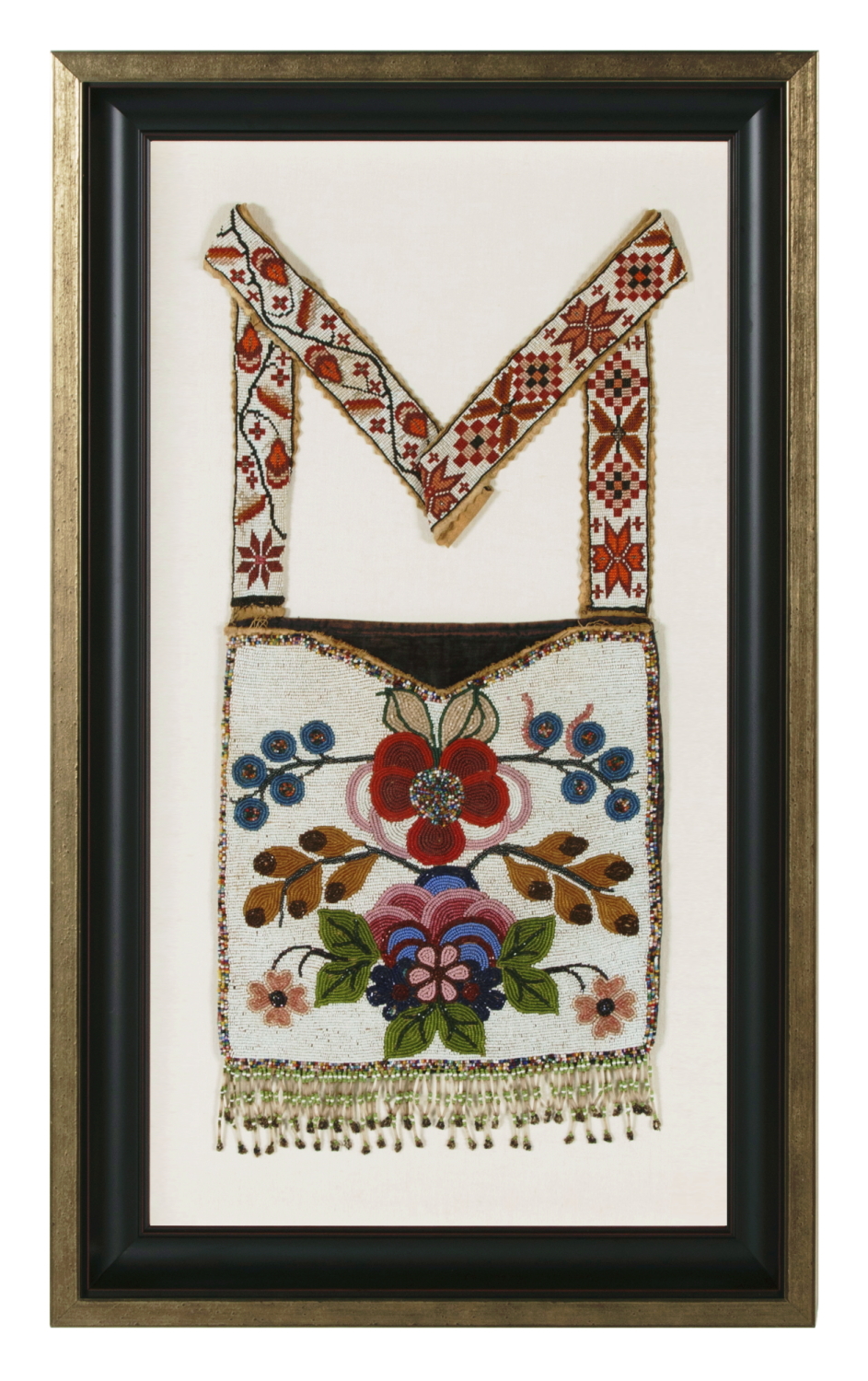
| |
BEADED NATIVE AMERICAN BANDOLIER BAG, GREAT LAKES OR WOODLANDS, circa 1880 |
| |
|
| Dimensions (inches): |
Frame - 32" tall x 19" wide x 2.5" deep |
| Description: |
|
Native American bandolier bag, constructed of deer or elk hide, muslin, and velvet, with wonderful beadwork decoration. Made ca 1885, the floral imagery on the face is bold and colorful, with reds, pinks, blues, greens, brown and gold. This appears on a white ground, edged with a fine border that exhibits all of these colors and many more. The pouch is trimmed with an especially attractive fringe along the lower edge, in green, brown and white, that features opalescent, tubular glass beads.
The strap is particularly interesting. Dominated by autumn colors, there is an 8-pointed, star-shaped flower near on the left, adjacent to the receptacle, followed by a black vine with crosshatch buds and teardrop-shaped fruit or flowers. On the opposite side there are different star shapes, interspersed with diamonds and various crosshatches, all of which were probably intended to illustrate flora. The contrasting use of serpentine vines on one side and geometric patterns on the other works surprisingly well because it was so creatively planned and executed.
The Great Lakes region Native American bandolier bag was copied from those used by European soldiers to carry cartridges for their rifles. Early bags did not have a pocket, but were solely for decoration. Later bags had generous pouches with a slit at the top and a strap, usually worn diagonally over the shoulder, thus resting the bag at hip level. Glass beads, a European trade good, replaced the traditional porcupine quills.
Beaded bandolier bags were produced mainly from the latter half of the 19th century through the first half of the 20th century, but they continue to be made today. Floral designs on bandolier bags are typical of the tribes of the Great Lakes region. Such designs first appeared around 1800 and by 1900 had become the dominant pattern in the area. They also appear on the bags made by the nearby Santee Sioux in the easternmost part of the Dakotas.
Bandolier bags are constructed and beaded by women, though they are used primarily to complete the ceremonial outfits worn by men. There are, however, examples of older women wearing them in photographs. Sometimes more than one bag is worn. These bags are considered objects of prestige within the tribes that produced them.*
* Source: Milwaukee Public Museum
Mounting: The bag has been hand-stitched to a background of 100% hemp fabric. It was then placed in a 2-part frame consisting of a modern molding with a scooped profile that has a very dark brown mat finish, nearly black, with red highlights, surrounded by a narrow gilded molding. A shadow box was created to accommodate the thickness of the textile and enhance its presentation. The glazing is U.V. protective Plexiglas.
Condition: Excellent overall. There is a small amount of fraying and there is some wear to the velvet along the mouth of the pouch. The stitching of the straps was at some time mended where they are joined to the pouch. |
|
|
| |
|
| Primary Color: |
gold, white, brown, red, green |
|
| Earliest Date: |
1875 |
|
| Latest Date: |
1885 |
|
| For Sale Status: |
Available |
|
| Price |
SOLD |
|
| E-mail: |
info@jeffbridgman.com |
|
 |
|
Page Views:... 1055 |
|


